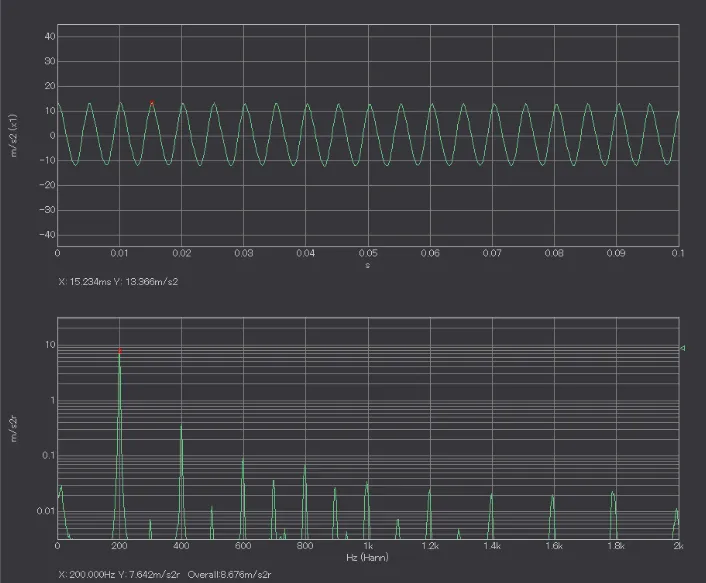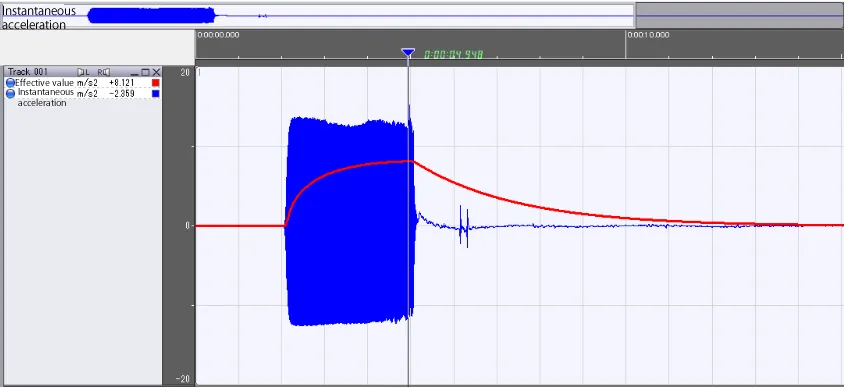No.18 AC/DC output of sensor amplifier
When using an accelerometer with a built-in preamplifier, it is necessary to supply power to its amplifier. Our accelerometer with built-in preamplifier uses a power supply mechanism called CCLD (Constant Current Line Drive). Depending on the manufacturers, it may be called such as IEPE and IPC, but the mechanism is the same.
Our FFT analyzers and Data Stations are equipped with a CCLD power supply function, thus an accelerometer with a built-in preamplifier can be directly connected. While, when connecting to an oscilloscope or A/D conversion board, it is necessary to use a sensor amplifier with power supply function.
Some sensor amplifiers have the output function that outputs the signal from a sensor as it is, or simply amplifies it, and converts to the signal called an efficient value. In such products, the former is called AC output and the latter is called DC output.
-CCLD compatible Sensor amplifiers
We provide CCLD compatible sensor amplifiers; the 2-ch sensor amplifier SR-2210 and the 3-ch sensor amplifier PS-1300.
The 2-ch sensor amplifier SR-2210 is a sensor amplifier that has a CCLD power supply function and a signal amplification function. It also has a frequency correction function (A/ C/ FLAT) that is used when connecting a microphone, but it is used with FLAT when connecting an accelerometer. There is no efficient value output (DC output) function.
The 3-ch sensor amplifier PS-1300 is also a sensor amplifier that has a CCLD power supply function and a signal amplification function. In addition, it has integration function, High/Low pass filter function. To add the PS-0131 Effective output function, it can output an effective signal (DC output) instead of a normal signal (AC output). The AC output is used when recording the time waveform of the accelerometer itself or analyzing its frequency. The effective value output (DC output) is used when recording only the magnitude of vibration without frequency analysis.
-Vibration of mobile phone vibrator
Figure 1 shows the time-axis waveform and its power spectrum when the vibration acceleration of the vibrator is measured attaching an accelerometer on a mobile phone. The half amplitude of the time axis waveform was 13.37 m/s2, and the overall (effective value) of the power spectrum was 8.68 m/s2. Looking at the power spectrum, the fundamental frequency of vibration was 200 Hz and its amplitude (effective value) was 7.64 m/s2. The second order or more of harmonic components were also observed.

Fig.1 Time waveform (upper) and Power spectrum (lower) of vibration acceleration for mobile phone vibrator
AC output of the sensor amplifier is shown as time axis waveform in the upper of Figure 1. The relationship between the acceleration value and the output voltage is determined by the sensitivity of the accelerometer [mV/(m/2)] and the gain of the amplifier (amplification factor).
-AC output/DC output for vibration of mobile phone vibrator
Figure 2 shows the waveforms of the acceleration signal (AC output) and the efficient value signal (DC output) of the mobile phone vibrator vibration. The vibrator vibrates for 3 seconds and then stops. The vibration for about 1 second after stop is caused by the button operation of the mobile phone, which does not affect the efficient value signal (DC output) as the duration is short.

Fig.2 AC output (blue) and DC output (red)
Since the PS-1300 efficient value output function uses an efficient value circuit with a time constant of 1.18 seconds to obtain the efficient value, the output does not increase immediately after the vibration starts, and it takes several seconds to reach 8.12 m/s2. After the vibration stops, it will slowly decrease.
The maximum value of the acceleration signal (AC output) is 15.25 m/s2. Since the efficient value is the root mean square value of the time waveform, the efficient value is always equal to or smaller than the maximum value. For a sine wave, the efficient value is 1/√2 (0. 707 times) of the maximum value, for general vibration, it is a fraction of the maximum value, and for impulse vibration, it is even smaller.
If you only need to measure the fluctuation of the magnitude of vibration, record the efficient value output (DC output) of the sensor amplifier, etc. The DC output value can be recorded a few times per second, and if the fluctuation of the magnitude is less, the recording is even less frequently. However, if an impulse vibration with a short duration occurs, it will not be reflected in the efficient value output (DC output). If you also want to monitor the maximum acceleration signal to detect impulse vibrations, you need to record the AC output at a sufficient sampling frequency.
-Summary
When recording the time waveform of the acceleration signal itself or when analyzing the frequency, it is necessary to use the system that can capture the signal at a sufficiently fast sampling frequency, such as an FFT analyzer, data station, or data logger. While, when simply recording the magnitude of vibration, if there is a sensor amplifier equipped with an efficient value signal output (DC output), it is sufficient to capture the data a few times per second or less. Vibration can be recorded with relatively inexpensive system.
For the above purpose, the 3-ch sensor amplifier PS-1300 is often used. Therefore, I have introduced the difference between the AC output and DC output of the sensor amplifier in this column.
(Y·K)
